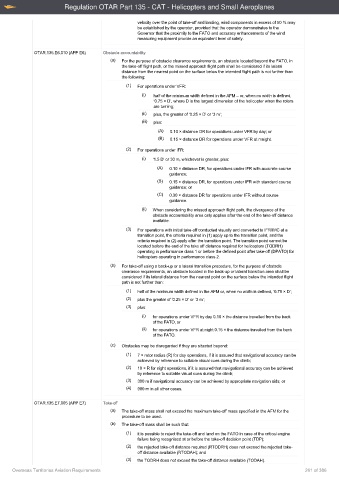Page 261 - Overseas Territories Aviation Requirements Consolidated - Total AOC
P. 261
Regulation OTAR Part 135 - CAT - Helicopters and Small Aeroplanes
velocity over the point of take-off and landing, wind components in excess of 50 % may
be established by the operator, provided that the operator demonstrates to the
Governor that the proximity to the FATO and accuracy enhancements of the wind
measuring equipment provide an equivalent level of safety.
OTAR.135.E6.010 (APP E6) Obstacle accountability
(a) For the purpose of obstacle clearance requirements, an obstacle located beyond the FATO, in
the take-off flight path, or the missed approach flight path shall be considered if its lateral
distance from the nearest point on the surface below the intended flight path is not further than
the following:
(1) For operations under VFR:
(i) half of the minimum width defined in the AFM – or, when no width is defined,
‘0.75 × D’, where D is the largest dimension of the helicopter when the rotors
are turning;
(ii) plus, the greater of ‘0.25 × D’ or ‘3 m’;
(iii) plus:
(A) 0.10 × distance DR for operations under VFR by day; or
(B) 0.15 × distance DR for operations under VFR at mnight.
(2) For operations under IFR:
(i) ‘1.5 D’ or 30 m, whichever is greater, plus:
(A) 0.10 × distance DR, for operations under IFR with accurate course
guidance;
(B) 0.15 × distance DR, for operations under IFR with standard course
guidance; or
(C) 0.30 × distance DR for operations under IFR without course
guidance.
(ii) When considering the missed approach flight path, the divergence of the
obstacle accountability area only applies after the end of the take-off distance
available.
(3) For operations with initial take-off conducted visually and converted to IFR/IMC at a
transition point, the criteria required in (1) apply up to the transition point, and the
criteria required in (2) apply after the transition point. The transition point cannot be
located before the end of the take off distance required for helicopters (TODRH)
operating in performance class 1 or before the defined point after take-off (DPATO) for
helicopters operating in performance class 2.
(b) For take-off using a back-up or a lateral transition procedure, for the purpose of obstacle
clearance requirements, an obstacle located in the back-up or lateral transition area shall be
considered if its lateral distance from the nearest point on the surface below the intended flight
path is not further than:
(1) half of the minimum width defined in the AFM or, when no width is defined, ‘0.75 × D’;
(2) plus the greater of ‘0.25 × D’ or ‘3 m’;
(3) plus:
(i) for operations under VFR by day 0.10 × the distance travelled from the back
of the FATO, or
(ii) for operations under VFR at night 0.15 × the distance travelled from the back
of the FATO.
(c) Obstacles may be disregarded if they are situated beyond:
(1) 7 × rotor radius (R) for day operations, if it is assured that navigational accuracy can be
achieved by reference to suitable visual cues during the climb;
(2) 10 × R for night operations, if it is assured that navigational accuracy can be achieved
by reference to suitable visual cues during the climb;
(3) 300 m if navigational accuracy can be achieved by appropriate navigation aids; or
(4) 900 m in all other cases.
OTAR.135.E7.005 (APP E7) Take-off
(a) The take-off mass shall not exceed the maximum take-off mass specified in the AFM for the
procedure to be used.
(b) The take-off mass shall be such that:
(1) it is possible to reject the take-off and land on the FATO in case of the critical engine
failure being recognised at or before the take-off decision point (TDP);
(2) the rejected take-off distance required (RTODRH) does not exceed the rejected take-
off distance available (RTODAH); and
(3) the TODRH does not exceed the take-off distance available (TODAH).
Overseas Territories Aviation Requirements 261 of 386

